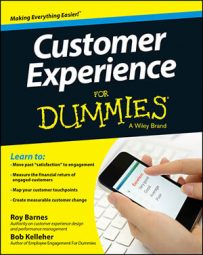Want to improve your own customer experience delivery in a hurry? Here are ten things you can change today that will make an instantaneous impact on your customer interactions.
Be patient. Patience, as they say, is a virtue — and it’s one that people who deal with customers must have in buckets. Here are some tips for dipping into your inner well of patience when dealing with a difficult customer (or other work frustrations):
Take a deep breath and let it out slowly.
If you’re dealing with a customer on the phone, ask her to hold for just one moment. Then consciously focus on relaxing your body.
If you’re dealing with a customer face-to-face, remove yourself from his presence for a moment. Step into a back-office area and slap a coworker if need be. (Kidding!)
Slow down your speech. Sometimes by acting patient, you can feel patient.
Try to remember that it’s not personal. The customer isn’t mad at you — at least, she shouldn’t be.
Really listen. It simply isn’t possible to truly help a customer if you don’t listen to her needs. Moreover, customers know when you’re not listening to them, and their frustration level rises accordingly.
Listening requires more than just hearing. To listen, you must really focus on what another person is saying. That means staying quiet and working hard to understand the message behind the other person’s words.
Know your stuff. You may have a winning smile, a personality without peer, and an uncanny ability to connect with customers. But if you’re not an expert on your company’s product or service, you are of absolutely no help to a customer who is in need of expertise.
Make it your mission to know your product and service line inside and out, so you’ll be able to answer just about any question a customer throws at you. Knowing your stuff enables you to move quickly, make the right decisions, and find workable solutions for your customers.
Show a yearn to learn. Yes, you should strive to become an expert in your area. But you’ll quickly find that the more you know about your area of expertise, the more there is to learn.
You must own your personal learning and development. Don’t wait for someone else to identify what you need to know. Seek feedback from lots of different sources on how to improve and develop. When training is offered, participate fully. Finally, integrate and apply what you learn into your everyday existing work style and flow.
Be proactive. If you’re looking to provide a great experience, you cannot be passive. You must take charge and control the experience the customer is going to receive. You must be proactive.
As soon as you understand a customer’s problem, work to offer a solution. If others need to be involved in the solution-making, reach out to them quickly. Gather all relevant information from whatever sources are available. Ideally, you’ll be able to solve the customer’s problem right away. If you can’t, tell the customer exactly how long it will be before you can, and then deliver on that timeline.
As you’re working to solve the problem, be decisive. Your ability to be decisive stems from your understanding of the nuances of your business. Don’t wait longer than is absolutely necessary to develop a plan of resolution and execute on it.
Follow through. If you tell a customer you’re going to do something, do it. Keep your word. Your promise is a commitment. And if you don’t have an answer just yet, let them know. Bad news is better than no news!
Persevere. Look, dealing with customers can be tough. No matter how patient, proactive, or engaging you are, every so often, somebody is just going to let you have it. Fairly or not, he’s going to direct all his pent-up anger and frustration at you. That’s where perseverance comes in.
Letting all those negative emotions roll off your back like water off a duck isn’t easy, but let them you must. You simply cannot permit yourself to wallow in the negativity. You must pick yourself up, dust yourself off, and let it go.
Be fast on your feet. Those who interact with customers on a regular basis must be fast on their feet. That is, they must be able to triage a situation without really thinking.
To help yourself prepare for this, establish a set of triage guidelines. Do this before you’re confronted with an unhappy customer. In these guidelines, include the name of your go-to person (or people) —that is, the person you’ll contact when you don’t know what to do.
Be sure to have his or her (or their) contact info handy. Also, decide what information you’ll send up the chain of command if you’re confronted with a customer challenge that is above your pay grade. Will you need to pass on verbatim recordings of an interaction? Will you need to share the customer’s purchase history with the company? Whatever it is, try to be ready to communicate the whole story.
Smile. Like yawning, smiling is contagious. Unless you’re super creepy, when you smile at somebody, that person will probably smile back. A sincere smile works wonders! If you can keep smiling even when everything around you is going to heck in a hand basket, you’ll find that others will smile, too.
Manage your body language. When it comes to how people perceive you, nonverbal communication — that is, body language — is extremely influential. Here are a few points to keep in mind:
Don’t shield your body.
Keep your hands away from your face.
Don’t fake-smile.
Watch where you stand; give the customer personal space.
Keep your hands out of your pockets.
Don’t fidget.
Stand up straight.
Face the person you’re talking to.
Stand still.

